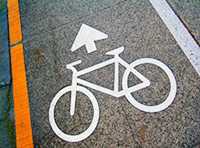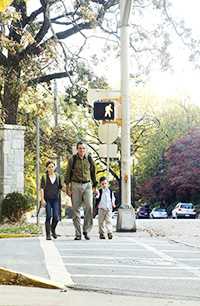Community Strategies
 Creating or modifying environments to make it easier for people to walk or bike is a strategy that not only helps increase physical activity, but can makes our communities better places to live. Communities designed to support physical activity are often called active communities. The Guide to Community Preventive Services recommends three strategies to increase physical activity that are related to walkability—community-scale urban design, street-scale urban design, and improving access to places for physical activity (including providing maps and descriptive information).1,2 Studies show more people bike and walk in communities where improvements have been made to biking and walking conveniences. This includes adding safer sidewalks, pedestrian crossings, and protected bike lanes.1 In addition, when people move to neighborhoods that are designed to promote physical activity and active transportation (mixed-use developments), they tend to spend less time in their cars and more time walking for transportation.3
Creating or modifying environments to make it easier for people to walk or bike is a strategy that not only helps increase physical activity, but can makes our communities better places to live. Communities designed to support physical activity are often called active communities. The Guide to Community Preventive Services recommends three strategies to increase physical activity that are related to walkability—community-scale urban design, street-scale urban design, and improving access to places for physical activity (including providing maps and descriptive information).1,2 Studies show more people bike and walk in communities where improvements have been made to biking and walking conveniences. This includes adding safer sidewalks, pedestrian crossings, and protected bike lanes.1 In addition, when people move to neighborhoods that are designed to promote physical activity and active transportation (mixed-use developments), they tend to spend less time in their cars and more time walking for transportation.3
Active Communities are Safer Communities
 Streets designed to be walkable and bike-able improve safety for everyone. Programs like Safe Routes to Schools improve the safety of children who walk and bike to school. These programs have shown reductions in traffic-related injuries.4,5 Communities designed to encourage walking increase the number of people out and about, thus increasing the number of "eyes on the street" and deterring illegal activity.6-8
Streets designed to be walkable and bike-able improve safety for everyone. Programs like Safe Routes to Schools improve the safety of children who walk and bike to school. These programs have shown reductions in traffic-related injuries.4,5 Communities designed to encourage walking increase the number of people out and about, thus increasing the number of "eyes on the street" and deterring illegal activity.6-8
Active Communities Support Social Cohesion
Going on a hike with a teenage child. Stopping to chat with neighbors while walking the dog. Biking down to the local coffee shop with a friend. Going outside for a "walking meeting" with colleagues. All of these are examples of how walking can help build social cohesion through interpersonal interaction.9
Active Communities Reduce Air Pollution
Improving the community environment so that people can choose to walk, bike, or take transit offers environmental benefits. Each time people choose to walk, bike, or take public transit rather than drive, they reduce the air pollution and greenhouse gases that their car would have produced.10-12
Active Communities Provide Economic Benefits
Features of active communities—pedestrian-friendly streets, protected bike lanes, compactness, mixed land use, and access to transit—have been shown to be associated with economic benefits to the community.13 These benefits can include higher home real estate values and higher levels of retail activity, and can lower the cost of providing public infrastructure and delivering services such as utilities.13 Active communities also prove to be attractive places for businesses to locate.13
Actions that States and Communities Can Take:
- Create or enhance physical activity environments to be pedestrian and bicycle friendly.
- Support community design and transportation planning policy to support walking and other forms of active transport.
- Implement strategies in the National Physical Activity Plan, and the National Prevention Strategy and CDC Recommendations for Improving Health through Transportation policy.
Resources
- Physical Activity: Built Environment Approaches Combining Transportation System Interventions with Land Use and Environmental Design
The Community Preventive Services Task Force recommends built environment strategies that combine one or more interventions to improve pedestrian or bicycle transportation systems with one or more land use and environmental design interventions to increase physical activity. - The CDC Guide to Strategies to Increase Physical Activity in the Community [PDF-1.2MB]
This document provides guidance for program managers, policy makers, and others on how to select strategies to increase physical activity in the community. - The National Physical Activity Plan
This comprehensive set of policies, programs and initiatives aim to increase physical activity in all segments of the American population. - The Community Guide
The Guide to Community Preventive Services is a free resource to help decision makers choose programs and policies to improve health and prevent disease in their community. - CDC’s Designing and Building Healthy Places
This website offers tools and evidence-based health strategies for community planning, transportation, and land-use decisions. - Health Impact Assessment
This assessment tool helps communities make informed choices about improving public health through community design. - Joint Use Agreements
These agreements increase opportunities for physical activity by allowing groups — usually a school and a city or private organization — to share indoor and outdoor spaces like gymnasiums, athletic fields and playgrounds to keep communities healthy.
This website provides resources to help establish these agreements. - Smart Growth
Smart growth helps communities grow in ways that expand economic opportunity while protecting human health and the environment. These reports from the Environmental Protection Agency’s Smart Growth Program are designed to inform developers, businesses, local government, and other groups about the benefits of smart growth development.- Smart Growth and Economic Success: Strategies for Local Governments (2014) discusses smart growth approaches local governments can use to lower costs and/or increase revenue.
- Smart Growth and Economic Success: The Business Case (2013) discusses how locations with housing and transportation options, a mix of uses close together, and a high quality of life can improve environmental outcomes while providing economic advantages for businesses.
- Smart Growth and Economic Success: Benefits for Real Estate Developers, Investors, Business, and Local Governments (2012) outlines the benefits of smart growth development for developers, businesses, local government, and other groups.
- Rethinking Streets: An Evidence-Based Guide to 25 Complete Street Transformations
"Complete streets" are designed to enable safe access for all users, including pedestrians, bicyclists, motorists and transit riders of all ages and abilities. This book uses examples from completed street projects from around the United States. -
Complete Streets Policies in the United States, 2006—2015
This series of maps from the National Complete Streets Coalition displays the progression in the adoption of state-level and local- or regional-level Complete Streets policies in the United States from 2006 through 2015.
References
- Heath GW, Brownson RC, Kruger J, et al. The effectiveness of urban design and land use and transport policies and practices to increase physical activity: a systematic review. Journal of Physical Activity and Health 2002;3:S55-76.
- Task Force on Community Preventive S. Recommendations to increase physical activity in communities. Am J Prev Med 2002;22:67-72.
- Mumford KG, Contant CK, Weissman J, Wolf J, Glanz K. Changes in Physical Activity and Travel Behaviors in Residents of a Mixed-Use Development. American Journal of Preventive Medicine 2011;41:504-7.
- DiMaggio C, Li GH. Effectiveness of a Safe Routes to School Program in Preventing School-Aged Pedestrian Injury. Pediatrics 2013;131:290-6.
- United States Department of Transportation, National Highway Transportation Safety Administration. Evaluation of the Safety Benefits of Legacy Safe Routes to School Programs.
- Newman O. Defensible space: Crime prevention through urban design. New York: Macmillan; 1973.
- Mair JS, Mair M. Violence prevention and control through environmental modifications. Annual review of public health 2003:24(1), 209-25.
- Jeffery C. Crime prevention through environmental design. Beverly Hills, CA: Sage Publications; 1971.
- Leyden KM. Social capital and the built environment: The importance of walkable neighborhoods. Am J Public Health 2003;93:1546-51.
- Grabow ML, Spak SN, Holloway T, Stone Jr. B, Mednick AC, Patz JA. Air Quality and Exercise-Related Health Benefits from Reduced Car Travel in the Midwestern United States. Environmental Health Perspectives 2012:68-76.
- Rabl A, de Nazelle A. Benefits of Shift from Car to Active Transport. Transport Policy 19 2010:121-31.
- Lindsay G, Macmillan A, Woodward A. Moving urban trips from cars to bicycles. Australian and New Zealand Journal of Public Health 2011;5.1:54-60.
- Smart Growth and Economic Success: Benefits for Real Estate Developers, Investors, Businesses and Local Governments: Environmental Protection Agency; 2012.
- Page last reviewed: May 4, 2017
- Page last updated: May 4, 2017
- Content source:



 ShareCompartir
ShareCompartir